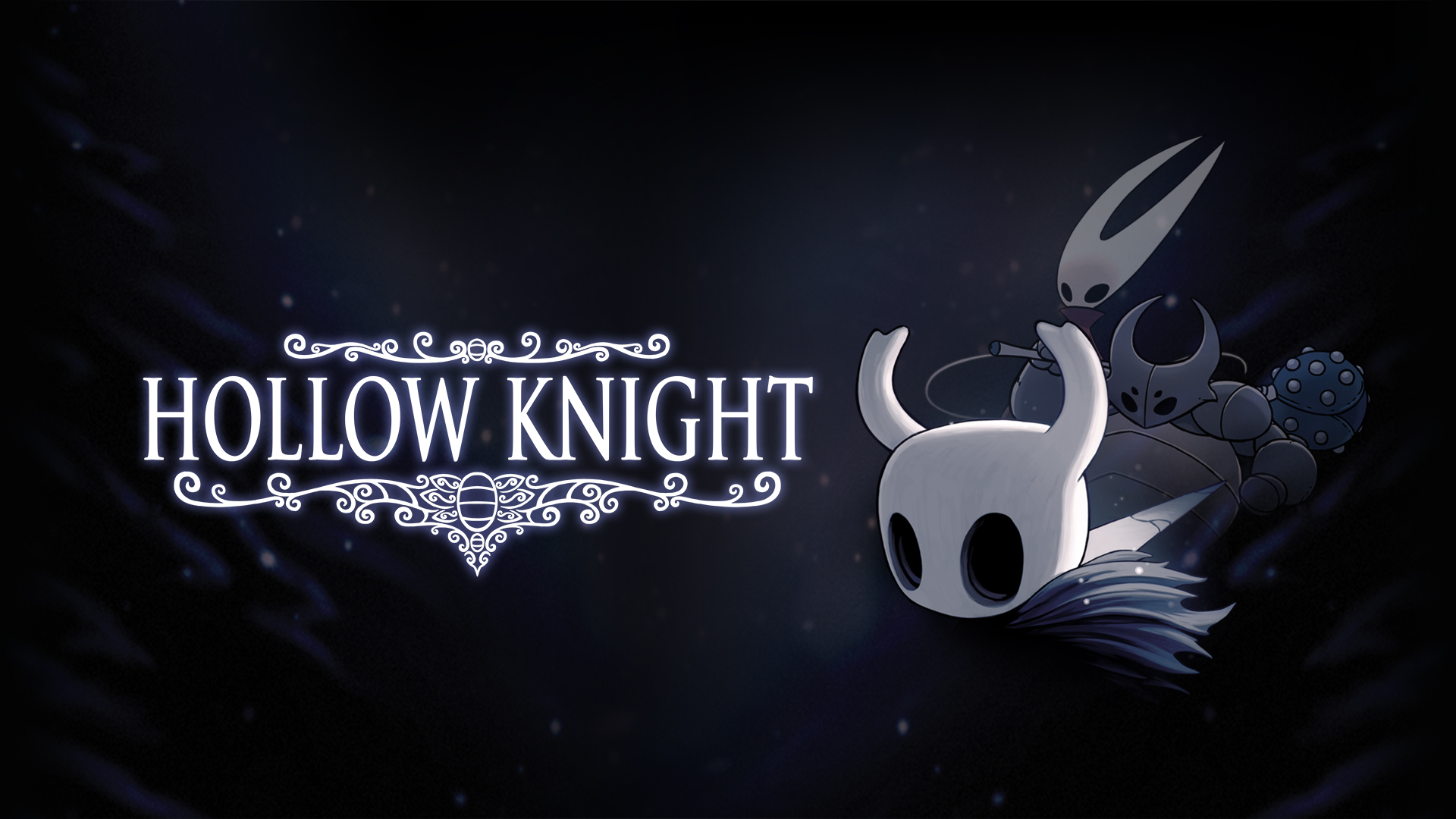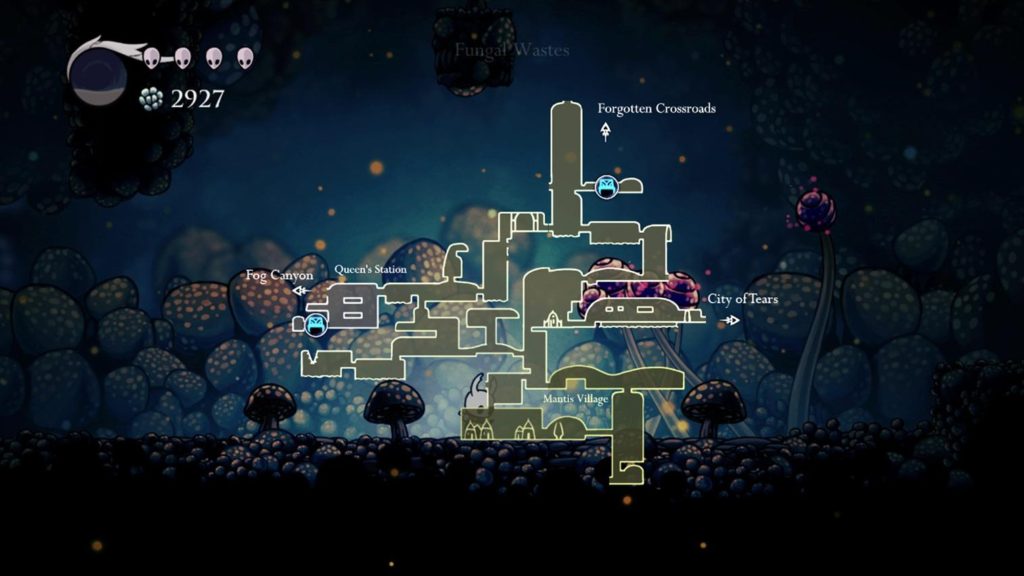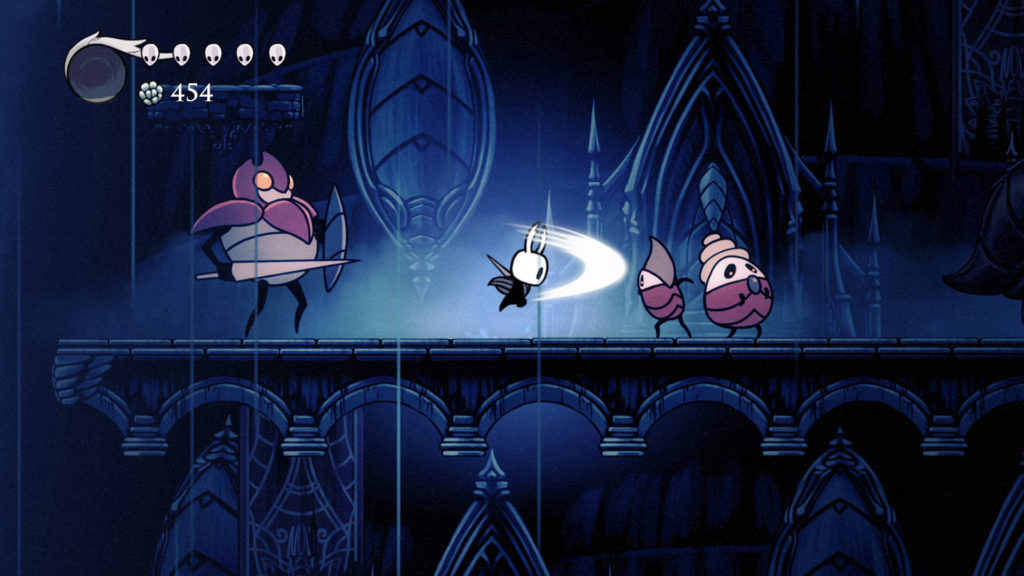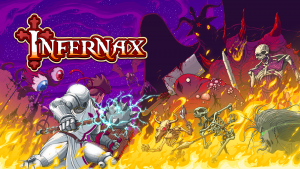
We seem to live in an era where genre mashups have become the norm, developers blending the design philosophies of previous classics to create interesting new mutations. Hollow Knight is an excellent example of this, combining the semi-open world and progression systems of 2-D Metroidvania games, with the Bloodstain mechanic and a style of world-building inspired by Dark Souls. That may sound reductive, considering that every third indie game uses this method of world design, and comparing games to Dark Souls is now so commonplace that it has become a meme, but these comparisons are genuinely important to understanding Team Cherry’s freshman debut.
Hollow Knight stars a nameless warrior who comes upon a settlement known as Hallownest, a maze-like underground kingdom. This is a land in decline, characterized by a population that has been ravaged by a strange disease known as the Infection. It’s also a place steeped in mystery. The majority of the story told in the margins of this world, and Hallownest’s history must be pieced together from optional encounters with the few sane individuals you chance across, enemy descriptions, and environmental storytelling. While this approach certainly isn’t for everyone, it does take advantage of the interactive nature of the medium, forcing players to piece together the clues for themselves.

Like most games of its genre, Hollow Knight lives and dies by the quality of its world design. Do Hallownests’ twisting corridors beckon the player with a steady stream of interesting hints around its periphery, subtly guiding us? Or is the map a tangling maze that baffles? Thankfully it skews towards the former, its central intrigue combining with an abundance of interesting locations that naturally meld into new areas. Each region offers fresh enemy types and unique geography, with secret areas hiding items that feel far more meaningful than just another missile upgrade. Most importantly it almost always felt as though there were many different avenues towards progress. As a result, exploration is enthralling because any small passageway can lead to an undiscovered area teeming with important new abilities. Admittedly there was a portion about 20 (ish) hours into my 35 hour run where my leads began to run out, and it took a decent amount of tedious backtracking to find new territories. I eventually broke through this rut, once again discovering locations and secrets at a satisfying pace, but that relatively brief slog stood out as particularly painful in an otherwise well-paced game.
As previously stated Hollow Knight utilizes a revival system inspired by Dark Souls; if you die, you drop all of your currency (Geo) where you stand and can only reclaim it by returning to the place of your demise. If you die again before reclaiming your loot, it will be lost for good. While on the surface this may seem like a cheap way to make the game harder, in reality this mechanic is meant to address a downside of our psychology. After dying, many players are left frustrated by their loss of progress, causing them to rush back to where they last died. This often results in carelessness, leading to far more deaths than would have happened otherwise. By penalizing this type of play, players are forced to remain careful at all times, reducing the number of quick deaths while also creating an exciting tension. Admittedly the game isn’t brutally hard, I don’t believe I ever lost my Geo entirely more than 1 or 2 times, but there were countless moments where I was on the razors edge of losing my loot, and many more than that where I barely escaped dying in the first place.
Losing your Geo can feel particularly costly due to the upgrades that can be purchased with it. In addition to finding masks that boost your health and soul, the progression is also defined by items called pins. These pins offer a great range of boosts, from something as simple as the Compass, which adds an indicator on the map on your current location, to something as important as improving your weapon’s range and attack speed. These items can be combined in interesting ways to create different builds, allowing for the clever exploitation of certain bosses or specific sections of gameplay. For instance, if you’re fighting enemies or bosses that fly around, pins can be combined to increase your long range spell’s effectiveness and regeneration. In addition to buying them outright, the pins can also be found hidden throughout the corners of the world, offering another all important incentive for exploration.

The combat is simple but satisfying, requiring the usage of the knight’s nail, which is ostensibly a sword. In addition to a normal horizontal slash, you can also perform a pogo-ing maneuver by timing your downward aerial strikes, allowing you to slash downwards on top of an enemy repeatedly. This basic action remains fun throughout, and is the key to many enemy and boss encounters. Parrying is also possible through careful sword strikes, although it generally feels like a less effective tactic than pogo-ing, due to many enemies attacking multiple times. There’s an impressive array of hostile bugs, ranging from weak slow moving Geemer-clones, to dangerous undead knights armed with swords and shields. The excess of foes is part of the reason why each area has a unique flavor, and the relatively simple combat is saved by the different build options and the need to learn the huge range of enemy attacks.
Additionally there’s an interesting loop between offense and defence. Attacking enemies earns soul, a resource which can be used to fuel ranges attacks or for healing. Since the only other way to heal is by finding a bench or rest-point, management of this resource is the key to staying alive. The flow of balancing attacking and healing becomes particularly interesting during the well-designed boss fights, trials which force you to memorise attack patterns and identify the best times to go on the offensive or mend your wounds. Unfortunately the platforming doesn’t feel quite as tight as the combat. While the basic movement options that are earned throughout Hollow Knight, such as air-dashes and wall jumps, feel decent on their own, some of the harder platforming sections draw from modern twitch platformers without providing the same level of responsiveness. Although your jump height varies based on how long the jump button is held, the dash can’t be canceled, which leads to many awkward deaths. Other actions, such as the wall jumps don’t come out as instantly as you would like. However, the worst part about taking damage during these sequences is that it completely breaks the healing loop, as when you aren’t hitting enemies, you aren’t accumulating soul. It felt like more of my lives were ended by these awkward platforming bits than anything else. Overall this isn’t a huge deal breaker, because there are only a few optional areas that have difficult chunks of platforming, but these stretches can be frustrating.

This macabre world is tied together by a similarly grave color palette, prioritizing blue, orange, and black. The painterly aesthetic vaguely calls to mind the bold extremes of German Expressionism through it’s limited coloring, while some of the deeper depths evoke some of the hellish repetition of HR Giger. While the design of the bugs certainly won’t be for everyone, I enjoyed the liberally employed juxtaposition between cute and sinister, some creatures exhibiting one over the other, while others embody both. While the majority of the world design scews towards the grim, there is a notable variety in the regions of the map. The occasional verdant jungle or dilapidated civilization pops out all the more thanks to this contrast, providing yet another incentive for exploration. The OST contributes to the melancholic tones perpetuated throughout, although some tracks do seem to offer a glimmer of optimism. My personal favorite is the theme for the the City of Tears, a mournful ode to a long dead metropolis. Admittedly, the game is much more of a tone piece dedicated to conveying a sense of decay than a concrete series of plot points, but the art style, soundtrack, and style of play all compliment that aim nicely.
Hollow Knight has component parts that can easily be traced to previous titles, but it successfully melds these ideas into a consistent whole. The center of the design is an elaborate world filled with secrets, it’s many branching labyrinths leading to new regions to explore. It was the tantalizing notion that around any corner could be a revolutionary upgrade, or undiscovered land that kept me thoroughly engaged over the course of my play-through. The core gameplay is more than competent, with straight forward combat that is elevated by the huge number of enemies and the interplay of pins with other upgrades. While the platforming feels arbitrarily punishing at times, the addition of a Bloodstain equivalent adds a rewarding sense of difficulty. And the relative brutality of the gameplay is mirrored by its dire tone, carried out through its aesthetics, sound design, and sparse character interactions. Simply put, it’s one of the best Metroidvania games in years, and an easy recommendation for those who enjoy branching, exploration driven games. If you want to experience a masterwork of video game overworld design, look no further than Hollow Knight.
Rating: 9.1/10







